Table of Contents
Unit 1 | Algebra
Page 1 | Expressions and Formulae
Page 3| Solving Linear Equations
Page 4| Expanding and Factorising
Page 5| Factorising Quadratics and expanding double brackets
Page 6| Patterns and Sequences
Page 7| Simultaneous Equations
Page 8| Changing the subject of a Formula
Page 9| Adding , subtracting algebraic formulas
Unit 2 |Graphs
Page 1 | Straight line graphs
Page 2 | Graphs of Quadratic functions
Unit 3 |Geometry and Measure
Page 2 | Symmetry
Page 3 | Coordinates
Page 4 | Perimeter, Area, Volume
Page 6 | Measurement
Page 7 | Trigonometry
Page 8 | Pythagoras
Page 9 | Angles
Page 10 | Shapes
Page 11| Time
Page 12 | Locus
Unit 4 | Numbers
Page 1 | Speed, Distance and time
Page 2 | Rounding and estimating
Page 3 | Ratio and proportion
Page 4 | Factors, Multiples and primes
Page 5 | Powers and roots
Page 7 | Positive and negative numbers
Page 8 | Basic operations
Page 9 | Fractions
Page 10 | Percentages
Unit 5 | Statistics and Probability
Page 1 | Sampling data (MA)
Page 2 | Recording and representing data
Page 3 | Mean median range and mode
Page 4 | Standard deviation
Unit 4 | Calculus
Area and Perimeter
L.O – To be able to calculate the area of rectangles, triangles, parallelograms, trapeziums and also more complex shapes.
Area of a rectangle
The formula for the area of a rectangle is:
Area = base x height
A = b x h
Example 1:
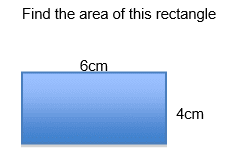
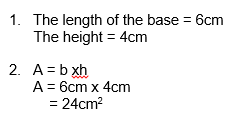
Steps:
- Identify the length of the base and the height of the rectangle.
- Using the formula, A= b x h, substitute b and h for the values identified in step 1.Remember units! For area always add a 2 , e.g. cm2, m2, km2 etc
Area of a triangle
The formula for the area of a triangle is:
Area = 1/2 × base × height
A = 1/2 x b x h
The height used must be the perpendicular height! This is especially important is you are not given a right angled triangle.
Steps:
- Identify the length of the base and the height of the triangle.
- Using the formula, A=1/2 x b x h, substitute b and h for the values identified in step 1.
Example 1:
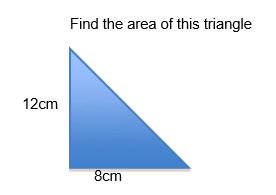
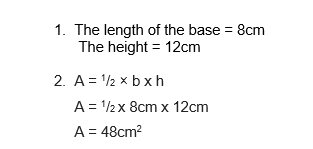
Steps:
- Split the shape up into simpler shapes e.g. triangles, squares and rectangles Draw each shape out separately and label the lengths of the sides (base and heights).You may need to work out some new lengths using the diagram and the lengths given.
- Find the area of each of the separate shapes.
- Add the areas of the separate shapes together. This will give you the area of the complex shape!
Area of complex shapes
Sometimes, you will have to split up a complex shape into smaller shapes. You find the area of these smaller shapes and add them up to find the area of the original shape.
Example 1:
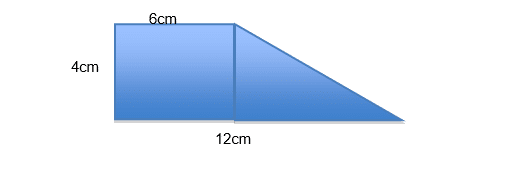
1.The two shapes that this complex shape is made up of
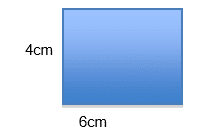
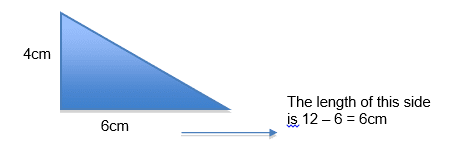
2.Area of rectangle = 4 x 6 = 24cm2
Area of triangle = ½ x 4 x 6 = 12cm2
3.Total area of complex shape = area of rectangle + area of triangle
=24cm2 + 12cm2
= 36cm2
Steps:
- Split the shape up into simpler shapes e.g. triangles, squares and rectangles Draw each shape out separately and label the lengths of the sides (base and heights).You may need to work out some new lengths using the diagram and the lengths given.
- Find the area of each of the separate shapes.
- Add the areas of the separate shapes together. This will give you the area of the complex shape!
Area of a parallelogram
The formula for area of a parallelogram is;
Area = base x perpendicular height
A = b x h
It is really important that you use the perpendicular height and not just the height of one of the slanted sides for h!
Example 1:
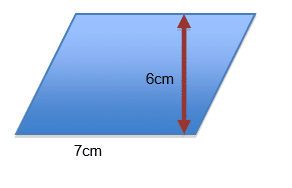
- The length of the base = 7cm
The perpendicular height = 6cm
- A = b x h
= 7cm x 6cm
= 42cm2
Steps:
- Identify the length of the base and the perpendicular height of the parallelogram.
- Using the formula, A= b x h, substitute b and h for the values identified in step 1. Remember units!
Don’t forget à use perpendicular height!
Area of a trapezium
The formula for the area of a trapezium is;
A = 1/2 × h × (a + b)
You must use the perpendicular height!
a and b are the lengths of the two parallel sides of the trapezium. It doesn’t matter which length is a/b.
Example 1:
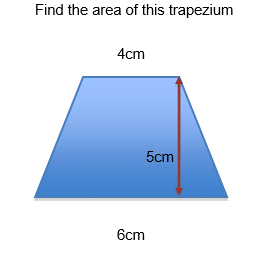
- Length of the base = 6cm
Perpendicular height = 5cm
Length of a = 4cm
Length of b = 6cm
- A = 1/2 × h × (a + b)
A = ½ x 5cm x (4cm +6cm)
A = 25cm2
Perimeter
The perimeter of a shape is the distance around it.
To work out the perimeter, all you have to do is add all of the sides of the shape together!
If you are given a complex shape, you may have to work out the length of some of the sides before you can find the perimeter.
Steps:
- Identify the length of the base and the height of the triangle.Also identify the lengths of the two parallel sides of the trapezium, a and b.
- Using the formula, A = 1/2 × h × (a + b), substitute b, h, a and b for the values identified in step 1.


